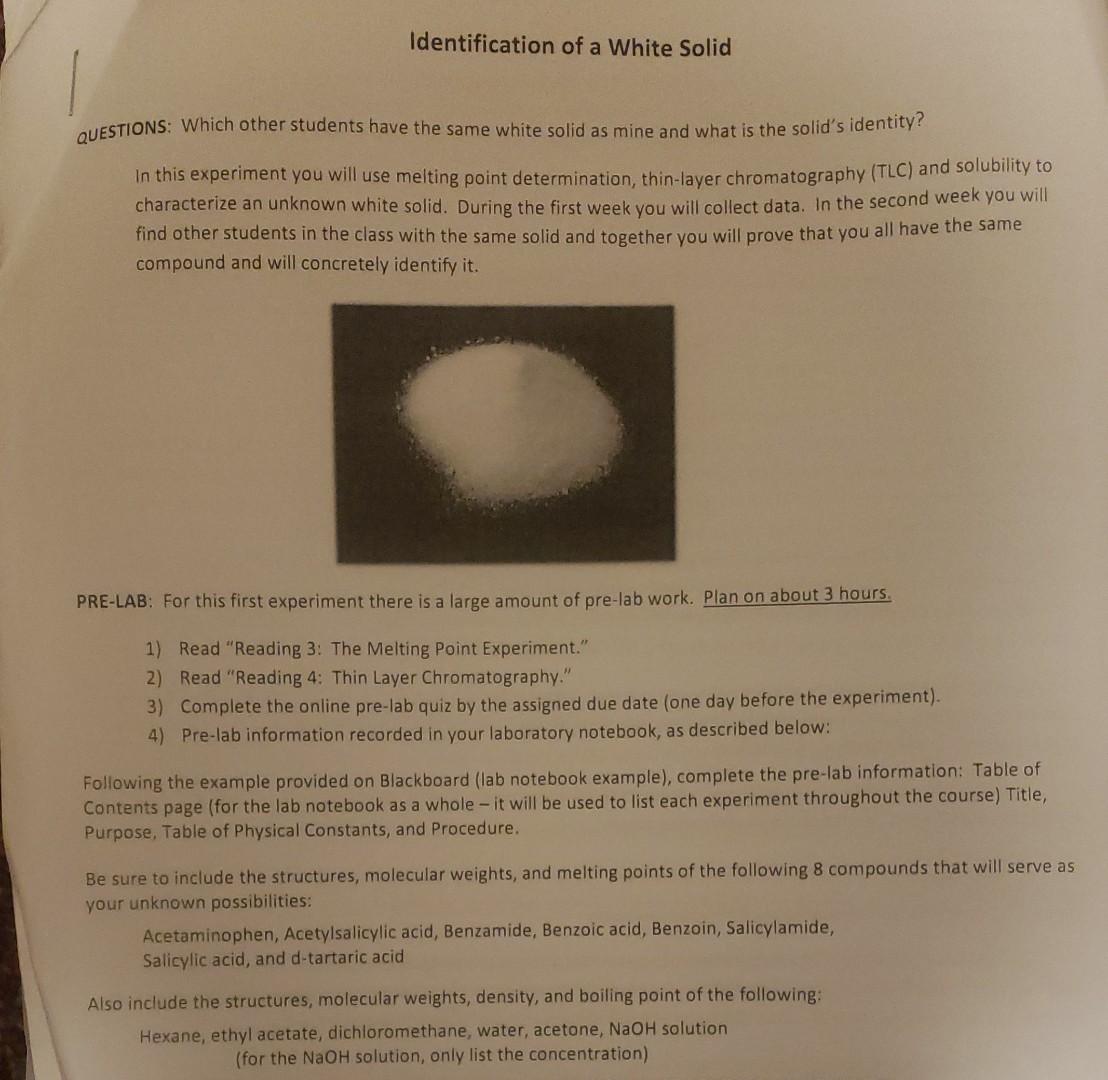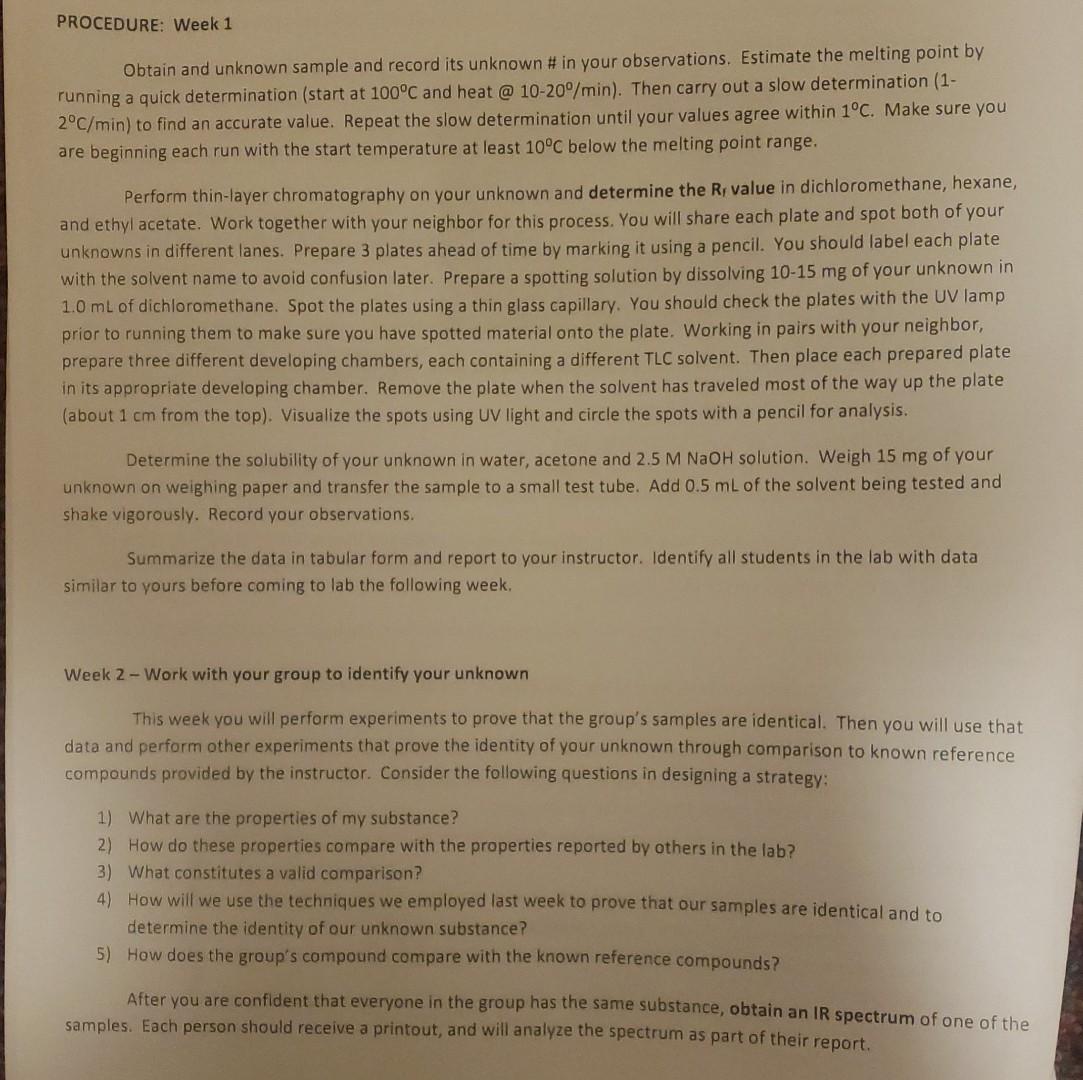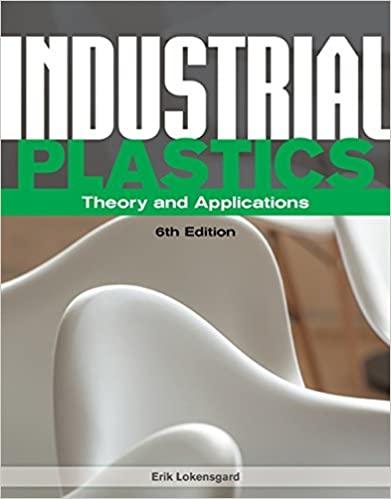Answered step by step
Verified Expert Solution
Question
1 Approved Answer
Which experiments should I use to identify the identity of my unknown? I know about performing a Mixed-melting point, but is there anything else I


Which experiments should I use to identify the identity of my unknown?
I know about performing a Mixed-melting point, but is there anything else I can do? What about TLC?
Identification of a White Solid QUESTIONS: Which other students have the same white solid as mine and what is the solid's identity? In this experiment you will use melting point determination, thin-layer chromatography (TLC) and solubility to characterize an unknown white solid. During the first week you will collect data. In the second week you will find other students in the class with the same solid and together you will prove that you all have the same compound and will concretely identify it. PRE-LAB: For this first experiment there is a large amount of pre-lab work. Plan on about 3 hours. 1) Read "Reading 3: The Melting Point Experiment." 2) Read "Reading 4: Thin Layer Chromatography." 3) Complete the online pre-lab quiz by the assigned due date (one day before the experiment). 4) Pre-lab information recorded in your laboratory notebook, as described below: Following the example provided on Blackboard (lab notebook example), complete the pre-lab information: Table of Contents page (for the lab notebook as a whole - it will be used to list each experiment throughout the course) Title, Purpose, Table of Physical Constants, and Procedure. Be sure to include the structures, molecular weights, and melting points of the following 8 compounds that will serve as your unknown possibilities: Acetaminophen, Acetylsalicylic acid, Benzamide, Benzoic acid, Benzoin, Salicylamide, Salicylic acid, and d-tartaric acid Also include the structures, molecular weights, density, and boiling point of the following: Hexane, ethyl acetate, dichloromethane, water, acetone, NaOH solution (for the NaOH solution, only list the concentration) PROCEDURE: Week 1 Obtain and unknown sample and record its unknown # in your observations. Estimate the melting point by running a quick determination (start at 100C and heat @ 10-20/min). Then carry out a slow determination (1- 2C/min) to find an accurate value. Repeat the slow determination until your values agree within 1C. Make sure you are beginning each run with the start temperature at least 10C below the melting point range. Perform thin-layer chromatography on your unknown and determine the R, value in dichloromethane, hexane, and ethyl acetate. Work together with your neighbor for this process. You will share each plate and spot both of your unknowns in different lanes. Prepare 3 plates ahead of time by marking it using a pencil. You should label each plate with the solvent name to avoid confusion later. Prepare a spotting solution by dissolving 10-15 mg of your unknown in 1.0 mL of dichloromethane. Spot the plates using a thin glass capillary. You should check the plates with the UV lamp prior to running them to make sure you have spotted material onto the plate. Working in pairs with your neighbor, prepare three different developing chambers, each containing a different TLC solvent. Then place each prepared plate in its appropriate developing chamber. Remove the plate when the solvent has traveled most of the way up the plate (about 1 cm from the top). Visualize the spots using UV light and circle the spots with a pencil for analysis. Determine the solubility of your unknown in water, acetone and 2.5 M NaOH solution. Weigh 15 mg of your unknown on weighing paper and transfer the sample to a small test tube. Add 0.5 mL of the solvent being tested and shake vigorously. Record your observations. Summarize the data in tabular form and report to your instructor. Identify all students in the lab with data similar to yours before coming to lab the following week, Week 2 - Work with your group to identify your unknown This week you will perform experiments to prove that the group's samples are identical. Then you will use that data and perform other experiments that prove the identity of your unknown through comparison to known reference compounds provided by the instructor. Consider the following questions in designing a strategy: 1) What are the properties of my substance? 2) How do these properties compare with the properties reported by others in the lab? 3) What constitutes a valid comparison? 4) How will we use the techniques we employed last week to prove that our samples are identical and to determine the identity of our unknown substance? 5) How does the group's compound compare with the known reference compounds? After you are confident that everyone in the group has the same substance, obtain an IR spectrum of one of the samples. Each person should receive a printout, and will analyze the spectrum as part of their reportStep by Step Solution
There are 3 Steps involved in it
Step: 1

Get Instant Access to Expert-Tailored Solutions
See step-by-step solutions with expert insights and AI powered tools for academic success
Step: 2

Step: 3

Ace Your Homework with AI
Get the answers you need in no time with our AI-driven, step-by-step assistance
Get Started


